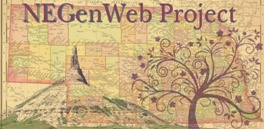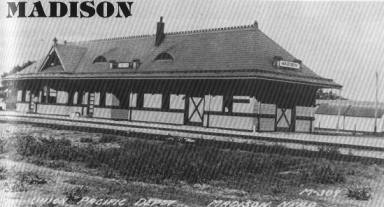 MADISON
-- MADISON COUNTY MADISON
-- MADISON COUNTY
It is believed by some that this area might have
been explored
by French trappers, perhaps the Mollet Brothers
(1739) who worked
the rivers in Nebraska, or by James McKay (1795),
just before it
became U.S.Territory in 1803.
A town, located at the junction of Union and Taylor
Creeks,
was founded in 1867 by Henry Mitchell Barnes and 20
German
families from Wisconsin. It soon became a prosperous
community.
Civil War veterans, looking for a place to establish
new homes,
chose the fertile lands found along the Elkhorn
River. Madison,
named for President James Madison, became a post
office address
in 1869.
The building of a railroad greatly influenced
Madison's
growth. The settlers were determined to obtain one!
At that time,
the nearest railroad was Columbus, 30 miles south.
To prove their
faith that a railway would eventually be built to
their town,
they broke sod for "the future depot" at the Fourth
of
July celebration in 1874. Train service did
eventually come, but
not until December 30, 1879.
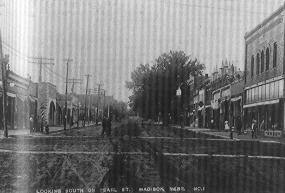 In the
meantime, Madison became the seat of government for
Madison
County in 1875. A three-way race developed between
two towns in
the northern part of the county, Battle Creek and
Norfolk, and
Madison in the south half. In addition to its
prospects of a
railroad, the reasons given for choosing this
location included
its geographic location, and "lower taxes." In the
meantime, Madison became the seat of government for
Madison
County in 1875. A three-way race developed between
two towns in
the northern part of the county, Battle Creek and
Norfolk, and
Madison in the south half. In addition to its
prospects of a
railroad, the reasons given for choosing this
location included
its geographic location, and "lower taxes."
Instrumental in winning the election was the fact
that Madison
had a newspaper. The "Madison County Review" was
unique, and quite an accomplishment for its founder,
T.M.
Blakely. After being printed in Chicago, the
newspaper was
shipped to Columbus by train and carried to Madison
on the mail
route. Later the paper became the "Madison
Chronicle,"
owned for a time by J. H. Slater. The present local
paper is the
"Madison Star Mail."
Madison became a principal shipping point between
Columbus and
Norfolk once the branch line of the Union Pacific
was completed.
Farmers and merchants prospered from having rail
connection, that
allowed their goods and products to be shipped
quickly and more
economically than by wagons.
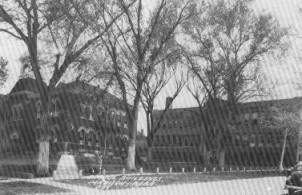 The
population grew to 300 in the late 1800s. New
businesses were
established; hotels, banks, general stores, law
firms, and
churches, in addition to the blacksmiths,
lumberyards, and
implement dealers of the early years. The
population grew to 300 in the late 1800s. New
businesses were
established; hotels, banks, general stores, law
firms, and
churches, in addition to the blacksmiths,
lumberyards, and
implement dealers of the early years.
A large race track was established and, for a short
period,
Madison also had a college. A new Union Pacific
depot was opened
on May 27, 1910.
Although Madison is not well known for its rare
natural
resources, both gold and oil were reported to have
been
discovered nearby. Gold nuggets, enough to fill a
water glass to
overflowing, were allegedly found on the J.F. Maurer
farm in the
green Garden precinct in 1931. At the same time,
"prospects
of oil" were said to be near the southeastern
section of
Madison County. However, the farmers declined to
sign over the
20,000 acres of land that were necessary for doing
the search.
Madison's economy is largely tied to agricultural
industries,
the production of corn and hogs, and a large pork
processing
plant. Other farm-related businesses include grain
elevators,
feed and seed stores, and a creamery.
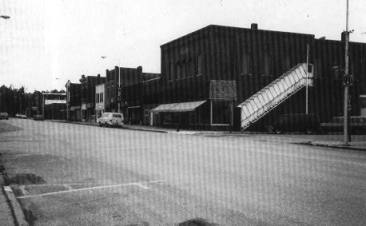 The city
still uses the original city hall and library. Even
though
Norfolk's population is more than 12 times greater,
the county
courthouse has remained in Madison. This is
reflected in such
businesses as a weekly newspaper, law firms, real
estate offices,
two banks, and a medical clinic. There are also a
variety of
stores that serve the population, currently
estimated to be
2,060. The city
still uses the original city hall and library. Even
though
Norfolk's population is more than 12 times greater,
the county
courthouse has remained in Madison. This is
reflected in such
businesses as a weekly newspaper, law firms, real
estate offices,
two banks, and a medical clinic. There are also a
variety of
stores that serve the population, currently
estimated to be
2,060.
Like the early pioneers' efforts, the present
town-leaders
continue to work toward community improvement and
growth with
dedication and determination. Madison, still many
years away from
a bicentennial celebration, looks forward to
providing a good
place to live and work for the future generations of
its
citizens.
By Susan Schmidt, Rte 1, Madison, NE 68748
ADDITIONAL MATERIAL: A Short History of Madison ,
1960, by
Modern Problems Class, Madison High School, Sheldon
Brown,
instructor; and information from Helen Henry, Art
Lee, McKibbon's
Phamracy, and the "Madison Star Mail. Pictures
provided by
Mary Schmidt and Penny Frazier.
|
